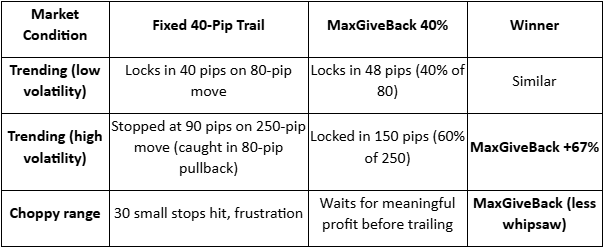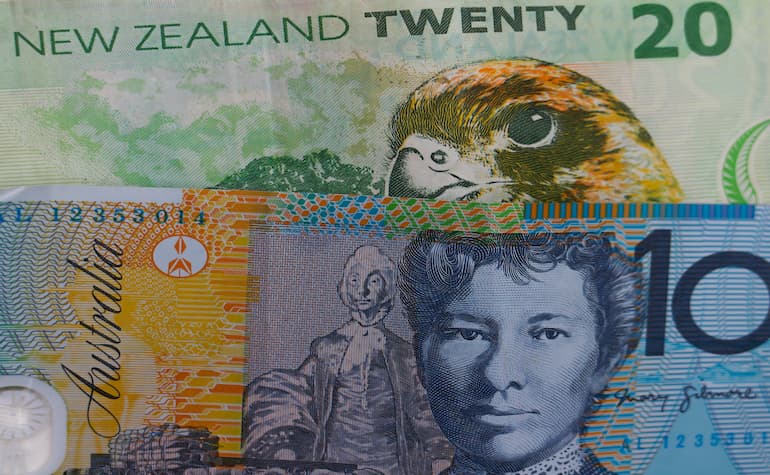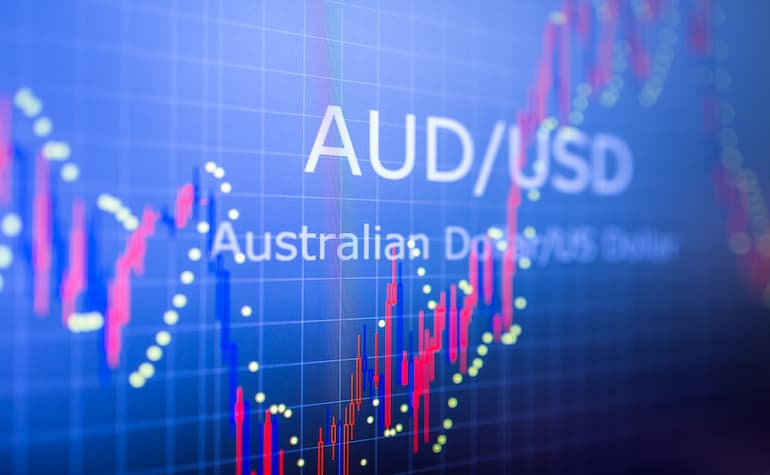Noticias del mercado & perspectivas
Anticípate a los mercados con perspectivas de expertos, noticias y análisis técnico para guiar tus decisiones de trading.

You've been using a 30-pip trailing stop for as long as you can remember. It feels professional, manageable and relatively safe.
But during volatile sessions, you see your winners get stopped out prematurely, while low-volatility winners drift back and hit stops that are relatively too tight.
Same 30 pips, different market contexts, but inconsistent in the protection of profit and overall results.
The Fixed-Pip Fallacy?
Traders gravitate toward fixed pip trailing stops because they feel concrete and calculable. The approach is easy to execute, readily automated through platforms like MetaTrader, and aligns with how most people naturally think about profit and loss.
But this simplicity masks a fundamental problem.
A twenty-five pip move in EURUSD during the London open represents an entirely different market event than the same move during the Asian session. The context matters, yet the fixed-pip approach treats them identically.
This becomes even more problematic when you consider different currency pairs. GBPJPY might have an average true range of thirty pips on an hourly chart, while EURGBP shows only ten. The same trailing stop applied to both instruments ignores the reality that volatility varies dramatically across pairs.
Timeframe introduces yet another layer of complexity. Take AUDUSD as an example: a ten-pip move on a four-hour chart barely registers as meaningful price action, but on a five-minute chart it represents a significant swing. The fixed-pip method treats these scenarios as equivalent.
The natural response might be to use something more sophisticated, like an ATR multiple. This accounts for your chosen timeframe, the instrument's normal volatility, and even session differences. But it brings its own complications.
When do you measure the ATR? Do you use the value at entry, knowing it might be distorted by sessional effects? Or do you make it dynamic, which becomes far more complex to implement in practice?
Perhaps there's another way forward that doesn't rely on abstract measures of volatility but instead responds directly to the movement of price in relation to the trade you're actually in—accounting for your lot size and the profit you've already captured.
Maximum Give Back: The Percentage Approach
Instead of asking "how do I protect profit after fifty pips," ask "how do I protect profit after giving back a certain percentage of open gains."
Consider a maximum give-back threshold of 40%. When your trade is up one hundred pips, the trailing stop activates if price retraces forty pips from peak, locking in a minimum of sixty pips.
But when that same trade reaches two hundred fifty pips of profit, the stop adjusts, and now it activates at a one-hundred-pip pullback, securing at least one hundred fifty pips. The stop distance scales naturally with the magnitude of the win you're sitting on.
This creates a logical asymmetry that fixed pip approaches miss entirely. Small winners receive tighter protection. Big winners get room to breathe.
The approach adapts automatically to what the market is actually giving you in real time, without requiring you to predict anything in advance.
You don't need to maintain a reference table where EURUSD gets thirty pips and GBPJPY gets sixty. You don't need different standards for different instruments at all.
The same 40% logic works whether the average true range is high or low, whether volatility is expanding or contracting. It survives regime changes without requiring recalibration because it's responding to the trade itself rather than to abstract measures of what the instrument normally does.
The market tells you how much it's willing to move in your direction, and you protect that information proportionally. Nothing more complicated than that.
Key Parameters to Specify in Your System:
- Maximum Give Back Percent: 30-50% is typical, but is dependent on how much profit retracement you can tolerate.
- Minimum Profit to Activate: In dollar amount or an ATR multiple form entry. This prevents premature exits on tiny winners, e.g., if it has moved 5 pips at 40% that would mean you are only locking in a 3-pip profit.
- Update Frequency: Potentially every bar. More frequent, but there may be issues if there is a limited ability to look at the market (if using some sort of automation, this could be programmed).
Is Maximum Giveback Always the Optimum Trail?
As with many approaches, results can be highly dependent on underlying market conditions. It is important to be balanced.
The table below summarises some observations when maximum giveback has been used as part of automated exits.

The major difference isn’t likely to be an increased win rate. It is about keeping more of your runners during high-volatility price moves rather than donating them back to the market.
It may not always be the best approach, as different strategies often merit different exit approaches.
There are two obvious scenarios where fixed pips may still be worth consideration.
- Very short-term scalping (sub-20 pip targets)
- News trading, where you want instant hard stops
Integrating Maximum Giveback With Your System
You may have other complementary exit filters in place that you already use. Remember, the ideal is often a combination of exits, with whichever is triggered first.
There is no reason why this approach will not work well with approaches such as set stops, take profits and partial closes (where you simply use maximum Giveback in the remainder as well as time-based exits.
Final Thoughts
To use fixed-pip trailing stops irrespective of instrument pricing, volatility, timeframe, and sessional considerations is the trading equivalent of wearing the same jacket in summer and winter.
Maximum Give Back trailing adjusts to the ‘market weather’. It won't make bad trades good, but it will stop you from cutting your best trades short just because your stop was designed for average conditions.
The market doesn't trade in averages but has specific likely moves dependent on context. Your exits should not be average either.


World’s largest company Apple Inc. (NASDAQ: APPL) announced the latest financial results after the market closed in the US on Thursday. After disappointing results last quarter, the company bounced back in the fiscal 2023 second quarter ended April 1, 2023, topping revenue and earnings per share (EPS) estimates. Company overview • Founded: April 1, 1976 • Headquarters: 1 Apple Park Way, Cupertino, California, United States • Number of employees: 164,000 (2022) • Industry: consumer electronics, software services, online services • Key people: Arthur D.
Levinson (chairman), Tim Cook (CEO), Jeff Williams (COO), Luca Maestri (CFO) The results Apple reported revenue of $94.836 billion for the quarter vs. $92.906 billion expected. Revenues were up down by 3% from the same period last year. EPS reported at $1.52 per share (unchanged year-over-year) vs. $1.429 per share expected.
The company announced a dividend of $0.24 per share. CEO commentary "We are pleased to report an all-time record in Services and a March quarter record for iPhone despite the challenging macroeconomic environment, and to have our installed base of active devices reach an all-time high," Apple’s CEO, Tim Cook said in a letter to investors. "We continue to invest for the long term and lead with our values, including making major progress toward building carbon neutral products and supply chains by 2030," Cook concluded. The stock was down by just shy of 1% at market close on Thursday at $165.77 a share.
Share price rose by around +2% in after-hours following the latest results. Stock performance • 1 month: +0.69% • 3 months: +9.93% • Year-to-date: +27.60% • 1 year: +5.75% Apple price targets • Rosenblatt: $173 • Baird: $180 • B of A Securities: $173 • Deutsche Bank: $170 • Barclays: $149 • JP Morgan: $190 • Wedbush: $205 • Credit Suisse: $188 Apple is the largest company in the world with a market cap of $2.640 trillion, according to CompaniesMarketCap. You can trade Apple Inc. (NASDAQ: APPL) and many other stocks from the NYSE, NASDAQ, HKEX, ASX, LSE and DE with GO Markets as a Share CFD.
Sources: Apple Inc., TradingView, MarketWatch, MetaTrader 5, Benzinga, CompaniesMarketCap, Wikipedia


American Express Company (NYSE: AXP) announced first quarter financial results before the market open on Thursday, setting a new quarterly revenue record. Company overview Founded: March 18, 1850 Headquarters: New York, United States Number of employees: 77,300 (December 2022) Industry: Banking, financial services Key people: Stephen J. Squeri (Chairman & CEO), Jeffrey C.
Campbell (Executive VP & CFO) The results American Express reported revenue that broke all previous quarterly records at $14.281 billion (up by 16% from the same period last year) vs. $13.981 billion expected. Earnings per share (EPS) reported at $2.40 per share (down by 12% year-over-year), falling short of analyst estimate of $2.656 per share. CEO commentary ''Our first-quarter results reflect strong growth in Card Member spending and continued high engagement with our premium products, tracking with the full-year 2023 guidance we provided in January, which we are reaffirming today, for revenue growth of 15 percent to 17 percent and earnings per share of $11.00 to $11.40,'' Stephen J.
Squeri, Chairman and CEO of the company said in a press release to investors. ''Revenue grew 22 percent from a year earlier to reach a quarterly record, as Card Member spending rose 16 percent on an FX-adjusted basis. Travel and Entertainment spending was particularly robust, growing 39 percent on an FX-adjusted basis and in March, we saw a record level of reservations booked on our Resy restaurant platform. We also saw an acceleration in spending in our International Card Services segment, which increased 29 percent on an FX-adjusted basis.
Spending on Goods and Services around the globe grew 9 percent on an FX-adjusted basis.'' ''Our customers have been resilient thus far in the face of slower macroeconomic growth, elevated inflation and higher interest rates, with credit performance remaining best-in-class. That said, we’re mindful of the mixed signals in the external environment.'' ''Based on our performance to date and the momentum we see in our business, we remain confident in our ability to achieve our longer-term growth plan aspirations,'' Squeri concluded. The stock was down by around -1% on Thursday at $162.41 per share.
Stock performance 1 month: -0.26% 3 months: +10.54% Year-to-date: +9.87% 1 year: -12.60% American Express price targets SVB Securities: $220 Piper Sandler: $179 BMO Capital: $197 Citigroup: $152 Jefferies: $170 American Express is the 109 th largest company in the world with a market cap of $120.91 billion, according to CompaniesMarketCap. You can trade American Express Company (NYSE: AXP) and many other stocks from the NYSE, NASDAQ, HKEX, ASX, LSE and DE with GO Markets as a Share CFD. Sources: American Express Company, TradingView, MarketWatch, MetaTrader 5, TipRanks, CompaniesMarketCap, Wikipedia


USD was firmer on Tuesday amid a light news calendar sparse in any key risk events. The US Dollar index again having a choppy session in a tight range with EURUSD weakness giving the Dollar a tailwind, also helping the greenback was ramped up US growth forecasts from Goldman Sachs and the World Bank hitting the wires. EUR was the G10 underperformer to see EURUSD hit lows of 1.0668 before finding support at a Fib level, this following a miss in German Industrial orders and an ECB consumers survey showing a sharp decline in inflation expectations.
Adding to the dovish tone was comments from ECB member Knot (a known hawk) who made some dovish comments declaring “the worst of inflation is behind us”. More ECB talk is scheduled for Wednesday which could add to this narrative. CAD managed to eke out some gains against the Dollar in a whipsawing session, USDCAD seeing a low low of 1.3391, breaching the key support level at 1.34.CAD was initially weighed on by lower oil prices, but an improved growth outlook saw Crude oil rebound with the CAD following suit.
Later today CAD traders will have all eyes on the BoC rate decision where the Central Bank is expected to hold rates at 4.5%, but there is a distinct possibility of a 25bps hike in the wake of the recent beats on GDP and CPI readings. Current market pricing has a 46% chance of a hike priced in, so will be line ball. GBP and JPY were modestly higher against the USD on the session.
JPY pared some of its initial strength by a rise in UST yields widening the UST-JGB differential. GBPUSD traded within a tight range, printing a low of 1.2392 and a high of 1.2458. Weak home building figures and a rising recession fear capping gains on cable as the BoE's aggressive rate hiking campaign appears to be slowing the economy.
AUD was the clear G10 outperformer after the RBA surprised the market again with a 25bps hike to 4.10%, which along with a hawkish RBA statement noting further rate hikes “may be required” seeing AUDUSD hit a high of 0.6685, falling just short of the 200DMA at 0.6692 and holding most of the gains post announcement throughout the session. For AUD watchers today Q1 GDP will be released today at 11:30 AEST, though it could have limited impact given the RBA already opted to hike rates yesterday. Calendar of today’s major risk events:


AUD and NZD, being cyclical currencies (cyclical currencies being ones that are extra sensitive to global risk sentiment) took a big hit in Fridays session, dropping 1.1% and 1.3% respectively against the USD and remain under pressure today. Weak retail sales out of the US on Friday didn’t help risk sentiment, but the rout really started when the USD soared on hawkish comments from Fed governors, (Waller being the most forceful) which saw rate hike odds at the next Fed meeting push significantly higher. Both the Aussie and Kiwi dollars have suffered from a shift in market pricing for continuing rate hikes in the United States and Europe, with Fed Funds futures now showing an 80% chance of another Fed hike in May and flirting with the risk of a 50bp hike from the ECB as both banks Governors continue to talk tough on inflation.
AUDUSD AUDUSD is technically still in an uptrend with an upward sloping trend line still in place, AUD was helped along by stellar employment figures out of Australia last week, though the forcefulness of the rejection at the 0.68 USD resistance zone on Friday does put into question how much legs this short-term uptrend has. Traders looking to enter the AUDUSD need to keep these levels in mind, a break and hold of the major 0.68 resistance could signal a push higher and resumption of the uptrend, a solid break through the short term trend would likely see the AUDUSD test 2023 lows before finding much buying. NZDUSD The Kiwi is showing similar price action to AUDUSD, with its major resistance and an area of a real battle between the Bulls and the Bears just above the psychological 0.63 level, with some short term support around the 0.6170 level.
There was a major rejection of the 0.63 level on Friday, in similar price action to the AUD, this also pushed NZDUSD below its 100 Day SMA (which has now turned on a downward trajectory) and just holding above its support zone. Like the AUD, a break below this support zone could see the Kiwi test the 2023 lows around 0.6080 before seeing buyers come back in, any push above 0.63 is likely to see some pushback and volatility in the NZDUSD pair. AUDNZD Despite higher yields in New Zealand the AUDNZD pair has rallied strongly in recent days, helped along by some small pricing in of a RBA hike next month after the strong jobs report.
The pair has now risen well into the 1.08’s after pushing below its 10-year median of 1.07 earlier in the month, showing that AUDNZD continues to be a good buy under this level. In economic news out of Australia, the RBA Minutes form the last RBA meeting will be released tomorrow, which could give clues as to whether the hold is temporary or not, plus NZ CPI figures will be released on Thursday. Inflation figures have been very important in recent times as indicators of Central Bank actions, so we could see some excitement on this figure.


The Aussie dollar has been fairly directionless since late February with it seemingly waiting for a catalyst to break it’s ranges and take the next leg up or down, data this week has failed to provide that. This opens up a couple of very good opportunities for traders, range trading the AUDUSD and mean reversion trades on the AUDNZD. Starting with AUDUSD, we’ve seen a very strong and tight range develop between a high of 0.6818 to a low of 0.6564 since late February, with the AUD moving in unison with risk sentiment, recently a push lower in this pair has been driven by US debt ceiling concerns, and haven flows into the USD.
Using an equidistant four-part grid the buy and sell zones to take advantage of this range trading opportunity become clear. While this range continues, buying in the green zones and selling in the red zones has so far been very successful. This looks likely to continue while the aforementioned US debt ceiling impasse remains in place, though traders will need to be on top of any developments, a resolution is likely to see risk roar back and the AUD take a leg up.
The other opportunity is the relative underperformance of the AUD vs its close neighbour, NZD. This has seen AUDNZD drop below its 10 year mean of 1.07, giving mean reversion traders an opportunity to buy this pair at a discount. Weekly chart of AUDNZD, showing how this mean reversion trade has worked over the last 8 years.
To help with entries, a shorter time frame chart can be used, below is the 4-hour chart showing a strong support zone has formed between 1.0650 – 1.0580 during the last month, where price has tested on multiple occasions before moving back to the 1.07 level. These are two of my favourite trading styles I’ve used over the years, but as always, have an exit plan and keep aware of macro happenings if you are looking to incorporate this style of trading into your toolbox. AUDUSD – US debt ceiling negotiations AUDNZD – RBA and RBNZ rate expectations


The U.S. Dollar Index (USDX, DXY, DX, or, informally termed “the Dixie") is a measure of the value of the United States dollar relative to a basket of foreign currencies. It is often used as an indicator of the overall strength or weakness of the U.S. dollar in the foreign exchange market.
Changes in the index value reflect shifts in the relative strength of the U.S. dollar compared to the other currencies in the basket. If the index rises, it suggests that the U.S. dollar is strengthening against the other currencies, and if it falls, it indicates a weakening dollar. The index is calculated using a geometric mean of the exchange rates between the U.S. dollar and a selected specific group of six major currencies.
A common misconception is the component currencies reflect what are commonly thought of as including the currencies that comprise the so called “majors”. However, the currencies that make up this basket are, the Euro (EUR), Japanese yen (JPY), British pound (GBP), Canadian dollar (CAD), Swedish krona (SEK), and Swiss franc (CHF) ONLY. These currencies are then weighted based on their importance in international trade and financial markets to create a quoted overall numerical value, and changes in this value may plotted on a chart as with any other tradable asset class over a set period of time.
Here are the weightings of currencies that make up the USD index currently: Euro (EUR) - Weight: 57.6% Japanese Yen (JPY) - Weight: 13.6% British Pound (GBP) - Weight: 11.9% Canadian Dollar (CAD) - Weight: 9.1% Swedish Krona (SEK) - Weight: 4.2% Swiss Franc (CHF) - Weight: 3.6% Please keep in mind that these weightings are subject to change, albeit infrequently, and it's recommended to refer to reliable financial sources for the most up-to-date information on the U.S. Dollar Index components and their respective weightings. The impact of the USD on other asset classes The U.S.
Dollar Index (USDX) can have a significant impact on various asset classes, as changes in the value of the U.S. dollar relative to other major currencies can influence global financial markets and economic conditions. Here's how the USDX can affect different asset classes: Foreign Exchange (Forex) Market: Currency Pairs: The most direct impact of the USDX is on currency pairs. When the USDX strengthens, the U.S. dollar is gaining relative to other currencies in the basket.
Bear in mind that this strength may neither be uniform against individual currencies nor in the degree of price move in specific USD crosses nor even, on occasion, in the same direction. Commodities: Commodity Prices: A stronger U.S. dollar can put downward pressure on commodity prices. Commodities like gold, oil, and copper are often priced in U.S. dollars globally.
A stronger dollar can make these commodities more expensive for holders of other currencies, hence often there is an inverse relationship to some degree on how these move versus the USD. Gold is often seen as a hedge against a weakening U.S. dollar. When the dollar strengthens, gold can become relatively less attractive to investors seeking safe-haven assets, potentially leading to lower gold prices.
Equity Markets: U.S. Stocks: A stronger dollar can impact multinational companies' earnings negatively. When the dollar appreciates, the overseas profits of U.S. companies become worth less when converted back to dollars, potentially leading to lower corporate earnings.
Emerging Markets: Many emerging market economies borrow in U.S. dollars. If the U.S. dollar strengthens, the debt servicing costs for these economies can rise, leading to economic challenges. As a result, some emerging market stocks can experience increased volatility or even significant economic pressure over time.
Bonds: U.S. Treasuries: The value of U.S. Treasury bonds can be influenced by the USDX.
A stronger dollar can attract foreign investors seeking higher yields, potentially driving up demand for U.S. Treasuries and affecting bond prices. Interest Rates and Central Banks: US Federal Reserve Policy: The strength of the U.S. dollar can influence the decisions of the U.S.
Federal Reserve regarding interest rates. A stronger dollar might give the Fed room to consider tighter monetary policy, while a weaker dollar might lead to more accommodative policies. It's important to note that market dynamics are complex and influenced by a multitude of factors only one of which may be the USD.
Other factors such as economic data, geopolitical events, and central bank actions also have significant impacts on various asset classes, often more so than the USD itself, and indeed may in turn influence the USD. Trading the USD index There are a few ways you can trade the USDX: Futures Contracts: The most direct way to trade the USDX is through futures contracts. These contracts are traded on exchanges like the Intercontinental Exchange (ICE).
They allow you to speculate on the future value of the USDX without actually owning the underlying currencies. The UDX futures trade on the ICE (Intercontinental Exchange, Inc.) for 21 hours a day. Exchange-Traded Funds (ETFs): Some ETFs track the performance of the USDX.
These ETFs attempt to replicate the movements of the index and can be bought and sold on stock exchanges like regular stocks. The most liquid of these is UUP. Options: Contracts allow you to buy or sell options on the USDX at a specified price before or on a certain date.
Contracts for Difference (CFDs): CFDs are derivative instruments that allow you to speculate on price movements without owning the underlying asset. We offer CFDs on the USDX futures contract, which can enable you to go long or short the asset. As part of the extensive product suite offered by GO Markets you have the opportunity to trade both the ETF referenced above, and the USD index (ticker code USDOLLAR). (Keywords: Forex, USD, US dollar, US dollar index, USDX, DXY, Futures contract)

